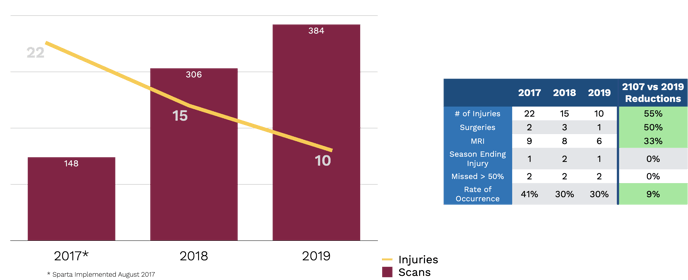Introduction
The Pac-12 is historically known for being one of the powerhouse conferences for NCAA baseball and continues to produce top Major League talent. Since 2011, the Pac 12 conference has housed four number 1 overall draft picks and has the most college world series championships in history. The Sun Devils of Arizona State University are no exception, as they recently generated the number 1 overall pick in the MLB draft and have the fourth most college world series appearances all time. It is without question, that players will not get recruited to ASU without a prerequisite of elite talent. The development and availability of this elite talent are paramount to the success of the Sun Devils baseball team.
Like many programs, ASU baseball had been operating under a more traditional model of reacting to injuries and implementing a return to play protocol. After dealing with high injury rates, the staff identified an opportunity for improvement utilizing technology to enhance their existing methodology and preparation strategies. The staff tracked KPIs such as the number of injuries, DL days, surgeries, and MRIs throughout the year. Needless to say, these KPIs are essential to track, but the staff was lacking the modifiable leading indicators that affect the outcome of these particular KPIs. The Athletic Director and the ASU baseball staff found promise in the Sparta system, as the assessments serve an objective scalable solution to positively influence their lagging indicators.
Challenge
Implement additional tech into the workflow of a traditional program in order to optimize the health and availability of student-athletes.
Solution
Overall Implementation - The Performance and Sports Medicine staffs began utilizing the Sparta suite of assessments (Balance, Plank, and Jump) to first identify their athletes’ Movement Signatures as well as their proprioception and core stability. The Jump Scan is utilized by the Performance staff on a monthly or biweekly basis depending on the time of year while the Sports Medicine staff utilizes the Balance and Plank Scan along with specific range of motion testing to prescribe exercise plans to address deficits, with the overall goal of reducing the risk of injury. The ASU team began tracking key lagging KPIs such as number of injuries, severity of injuries, and number of surgeries to longitudinally evaluate the effectiveness of their training. These metrics allow for a feedback loop to validate their use of the Sparta assessments and interventions.
Assessment Strategy
The performance staff administers the Jump Scan on a 4-week cadence during the off-season as a way to objectively measure how athletes adapt to training. During the season they move to a 2-week cadence to better understand acute changes and make proactive adjustments to their recovery and preparation strategies.
The medical staff administers the Plank and Balance Scans in addition to range of motion testing during their pre-participation evaluation. Athletes who score below a threshold of 48 on either the Plank or Balance are prescribed supplemental exercises and scan on a more frequent cadence until they scored above the 48 threshold.
Incoming Freshman - The staff takes a slightly different approach with incoming freshmen as most are in the early stages of development and typically have lower training ages. The staff utilizes the initial Jump, Balance, and Plank Scans as an opportunity to educate the freshman on their training processes. Considering that younger athletes tend to have more deviation in the Movement Signature early on, the staff assigns a general program that focuses on mastering the fundamental exercises they will perform. During this time, the performance staff continues to scan the athletes to monitor their responses to training. After completion of the general program, the staff typically observes a normalized trend of each athlete’s Movement Signature, allowing them to progress to a targeted training plan.
Education Strategy
COMMON CHALLENGE: The head strength and conditioning coach at ASU led the existing coaching staff for several years and felt they had developed a sound program with relatively good alignment within each department. So when approached with the Sparta system there was a natural hesitation for change. An initial pain point for the staff was the misunderstanding that to utilize Sparta they must operate under strict parameters and prescriptions set by the Sparta System, taking away their autonomy and ability to apply their own expertise.
An onsite implementation visit occurred over a two day period with a Sparta Customer Success Manager and the ASU baseball staff. While learning about the Sparta system, the staff welcomed the fact that this technology was something that could complement their existing approach, and not replace it. After the initial training and education, the ASU strength and conditioning staff quickly realized the Sparta System provides them the necessary data to make individual adjustments while fitting within their current system.
While change can be difficult and uncomfortable for any program, the staff saw value in the Sparta system and embraced this new approach with the mindset that if they did not look for additional ways to evolve and adapt, they could get left behind.
“You really have to get over the insecurities of - ‘I do it this way, it works, I’m not changing.’”
—Jason Robbins
Educating Athletes - Splitting the implementation duties between the performance (Jump Scan) and medical staff (Balance and Plank Scans) allows each to collectively communicate and interpret the scans’ results more efficiently.
Communicating the assessment results to the athlete presents an opportunity to empower the athlete to take ownership of their own development and preparation. When communicating the scan results to the athletes the staff found that it’s best received when relating it back to the athlete’s on-field development and performance. For example: When the medical staff observed the athletes in the Plank and Balance scan, they found that the higher performers and less injured athletes were often the ones with the higher scores. This conclusion allowed the staff to drive home the value of the assessment and assigned corrective plan in their training approach.
Moreover, consistency in scanning allowed each athlete to maintain awareness of their Movement Signature and progression while understanding the importance related to their field position.
Intervention Strategy:
The performance staff utilize the scan data from the vertical jump to build four different buckets of individualized training plans:
- Low Explode
- Low Drive
- Low Load & Explode
- Low Load & Drive
They established the most ‘bang for the buck’ movement for each plan and assigned it as the primary lift for each group. As time progressed, the staff continued to refine their prescriptive model and eventually made adjustments to plyometrics and accessory lifts to specifically address the need for each training plan. Special considerations are made to the upper body portion of the training session to address the different positional demands of pitchers and position players.
The medical staff utilizes the Plank and Balance scan to evaluate athletes’ proprioception, global stability, and identify deficiencies throughout the kinetic chain. Athletes who score below the 48 threshold are prescribed exercise plans and re-evaluated on a 4-week cadence. In conjunction with the Plank and Balance, exercise plans are also assigned based on the results of a joint-by-joint range of motion evaluation. Since training time is extremely limited in collegiate sports, the staff holds the athletes accountable for completing their supplemental programs on their own in the training room, before on-field workouts, post-weight room sessions, or during their personal time. Upon re-evaluation, the staff administers the Plank and Balance to check progress and make adjustments. This feedback loop provides insight and talking points for the athletic training staff and naturally creates accountability from the athlete.
Benefit
Inserting the Sparta assessments into ASU’s existing system gave the staff the necessary tools to make strategic adjustments and positively influence their lagging KPI’s. The fear of disrupting their established training culture was quickly neutralized as their bucketing approach allowed them to continue to train as a team and maintain comradery. Additionally, the feedback loop and athlete education reinforced the importance of overall health and created a sense of ownership and buy-in on behalf of the athletes. Player development success cases, proactive in-season athlete management, and reduction of injury further validated their newly implemented systematic approach and also led to trust and alignment within the performance, medical, and coaching staffs.
Results
Since the 2016-2017 season the ASU baseball team continues to report positive impacts on overall injury metrics.

